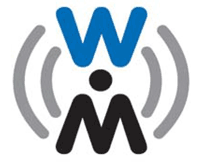IEEE 802.15 is a working group of the Institute of Electrical and Electronics Engineers (IEEE) IEEE 802 standards committee which specifies Wireless Specialty Networks (WSN) standards. The working group was formerly known as Working Group for Wireless Personal Area Networks.

IEEE 802.11 is part of the IEEE 802 set of local area network (LAN) technical standards, and specifies the set of medium access control (MAC) and physical layer (PHY) protocols for implementing wireless local area network (WLAN) computer communication. The standard and amendments provide the basis for wireless network products using the Wi-Fi brand and are the world's most widely used wireless computer networking standards. IEEE 802.11 is used in most home and office networks to allow laptops, printers, smartphones, and other devices to communicate with each other and access the Internet without connecting wires. IEEE 802.11 is also a basis for vehicle-based communication networks with IEEE 802.11p.
The ISM radio bands are portions of the radio spectrum reserved internationally for industrial, scientific, and medical (ISM) purposes, excluding applications in telecommunications. Examples of applications for the use of radio frequency (RF) energy in these bands include RF heating, microwave ovens, and medical diathermy machines. The powerful emissions of these devices can create electromagnetic interference and disrupt radio communication using the same frequency, so these devices are limited to certain bands of frequencies. In general, communications equipment operating in ISM bands must tolerate any interference generated by ISM applications, and users have no regulatory protection from ISM device operation in these bands.

In telecommunications, orthogonal frequency-division multiplexing (OFDM) is a type of digital transmission used in digital modulation for encoding digital (binary) data on multiple carrier frequencies. OFDM has developed into a popular scheme for wideband digital communication, used in applications such as digital television and audio broadcasting, DSL internet access, wireless networks, power line networks, and 4G/5G mobile communications.

A personal area network (PAN) is a computer network for interconnecting electronic devices within an individual person's workspace. A PAN provides data transmission among devices such as computers, smartphones, tablets and personal digital assistants. PANs can be used for communication among the personal devices themselves, or for connecting to a higher level network and the Internet where one master device takes up the role as gateway.

In telecommunications, direct-sequence spread spectrum (DSSS) is a spread-spectrum modulation technique primarily used to reduce overall signal interference. The direct-sequence modulation makes the transmitted signal wider in bandwidth than the information bandwidth. After the despreading or removal of the direct-sequence modulation in the receiver, the information bandwidth is restored, while the unintentional and intentional interference is substantially reduced.
Ultra-wideband is a radio technology that can use a very low energy level for short-range, high-bandwidth communications over a large portion of the radio spectrum. UWB has traditional applications in non-cooperative radar imaging. Most recent applications target sensor data collection, precise locating, and tracking. UWB support started to appear in high-end smartphones in 2019.

IEEE 802.20 or Mobile Broadband Wireless Access (MBWA) was a specification by the standard association of the Institute of Electrical and Electronics Engineers (IEEE) for mobile broadband networks. The main standard was published in 2008. MBWA is no longer being actively developed.
IEEE 802.15.4 is a technical standard which defines the operation of a low-rate wireless personal area network (LR-WPAN). It specifies the physical layer and media access control for LR-WPANs, and is maintained by the IEEE 802.15 working group, which defined the standard in 2003. It is the basis for the Zigbee, ISA100.11a, WirelessHART, MiWi, 6LoWPAN, Thread, Matter and SNAP specifications, each of which further extends the standard by developing the upper layers which are not defined in IEEE 802.15.4. In particular, 6LoWPAN defines a binding for the IPv6 version of the Internet Protocol (IP) over WPANs, and is itself used by upper layers like Thread.

Worldwide Interoperability for Microwave Access (WiMAX) is a family of wireless broadband communication standards based on the IEEE 802.16 set of standards, which provide physical layer (PHY) and media access control (MAC) options.

The WiMedia Alliance was a non-profit industry trade group that promoted the adoption, regulation, standardization and multi-vendor interoperability of ultra-wideband (UWB) technologies. It existed from about 2002 through 2009.
In radio resource management for wireless and cellular networks, channel allocation schemes allocate bandwidth and communication channels to base stations, access points and terminal equipment. The objective is to achieve maximum system spectral efficiency in bit/s/Hz/site by means of frequency reuse, but still assure a certain grade of service by avoiding co-channel interference and adjacent channel interference among nearby cells or networks that share the bandwidth.
IEEE 802.11a-1999 or 802.11a was an amendment to the IEEE 802.11 wireless local network specifications that defined requirements for an orthogonal frequency-division multiplexing (OFDM) communication system. It was originally designed to support wireless communication in the unlicensed national information infrastructure (U-NII) bands as regulated in the United States by the Code of Federal Regulations, Title 47, Section 15.407.
IEEE 802.11b-1999 or 802.11b is an amendment to the IEEE 802.11 wireless networking specification that extends throughout up to 11 Mbit/s using the same 2.4 GHz band. A related amendment was incorporated into the IEEE 802.11-2007 standard.
IEEE 802.15.4a was an amendment to IEEE 802.15.4-2006 specifying that additional physical layers (PHYs) be added to the original standard. It has been merged into and is superseded by IEEE 802.15.4-2011.
There are several uses of the 2.4 GHz ISM radio band. Interference may occur between devices operating at 2.4 GHz. This article details the different users of the 2.4 GHz band, how they cause interference to other users and how they are prone to interference from other users.
IEEE 802.11ac-2013 or 802.11ac is a wireless networking standard in the IEEE 802.11 set of protocols, providing high-throughput wireless local area networks (WLANs) on the 5 GHz band. The standard has been retroactively labelled as Wi-Fi 5 by Wi-Fi Alliance.
The IEEE 1902.1-2009 standard is a wireless data communication protocol also known as RuBee, operates within the Low Frequency radio wave range of 30–900 kHz. Although very resistant to interference, metal, water and obstacles, it is very limited in range, usually only suitable for short-range networks. The baud rate is limited to 1,200 kB/s, making it a very low-rate communication network as well. This standard is aimed at the conception of wireless network of sensors and actuators in industrial and military environments. One of the major advantage 1902.1 tags is they are extremely low power and last for years on a simple coin size battery and they can be sealed in a MIL STD 810G package. RuBee tags emit virtually no RF and do not produce any Compromising Emanations, as a result are used in high security facilities. RuBee tags are safe and in use near and on high explosive facilities.
A low-power, wide-area network is a type of wireless telecommunication wide area network designed to allow long-range communication at a low bit rate between IoT devices, such as sensors operated on a battery.

LoRa is a physical proprietary radio communication technique. It is based on spread spectrum modulation techniques derived from chirp spread spectrum (CSS) technology. It was developed by Cycleo, a company of Grenoble, France, and patented in 2014. Cycleo was later acquired by Semtech.











